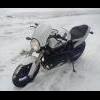I found this on a site I'm sure one of these methods will work along with the others that have been mentioned.
To remove the tree sap from your vehicle's surface, you can use finger nail polish remover on a cotton ball. After the sap is removed, make a paste of water and baking soda to wash the affected area, then apply wax.
Another method to remove the sap is to use mineral sprits (it will also remove tar). Use a soft, terry towel, or wash cloth dampened with mineral sprits. After removal, wash the car and apply wax to the affected area.
Tree sap can also be removed by using a water-soluble paint brush cleaner. A common household solution is bacon grease or lard. Just rub it on, and off comes the sap. To get tree sap off of your hands, simply rub mayonnaise on them and wash it off. To remove tree sap and other substances, you can use common solvents like lighter fluid, rubbing alcohol, WD-40 or even Skin-So-Soft bath oil.
The way to use those materials is to let them do their work of dissolving (in the case of alcohol) or softening (in the case of oils), enough to rub off the remaining sap. If you use the oil, wash the car afterwards to remove it.
You can also use commercial wax and grease-removing products available at auto supply stores. Be sure to wash and dry the car before applying the wax and grease remover. Then dampen a clean cloth with the solvent and rub the affected area. It may require several attempts if the sap is very thick or extremely hard. The surface may appear hazy after the solvent evaporates, but a good wax application will eliminate the haze and complete the job.
Removing tree sap from a car's finish is a bit more difficult than tar, as hardened sap can scratch your paint. I've found that by hand-rubbing the sap spots with mineral spirits or denatured alcohol, I'm able to easily remove the sap without damaging the finish. Mineral spirits and denatured alcohol acts as a solvent to break up and dissolve the sap.
If there is a large amount of sap on the car, or if the sap has been left on the finish for an extended period of time, it can be a lot of work to remove. For these cases, you can try hitting the affected areas with a light-duty buffing compound to remove the hardened surface on the sap spots. Then you can use mineral spirits or a similar solvent to remove it. The light duty buffing compound softens the sap so the solvent can do its job. The goal is to use the least pressure possible to reduce the risk of scratching the paint. After removing heavy sap, always buff the treated areas with a good polish to clean up any marks created during hand-rubbing with solvent. The treated area must also be re-waxed.
Another technique is to use orange based solvents and children's molding clay. Apply a bit of the solvent and rub with the clay. It is abrasive enough to scrub off the sap which has been broken down by the solvent.
The chemicals used to remove road stains can also remove your wax or sealants. After removing tar, sap or bugs, plan to spot wax or re-wax your vehicle. If you don't have time to wax right away, use a quick detailing spray that contains wax. A quick spray wax is great for this kind of spot waxing, too.
Old tar, tree sap, and paint over-spray can be easily removed with a miraculous new product called automotive clay. As you rub it across any type of surface (paint, glass, plastic, metal, rubber, vinyl) it instantly sticks-to and pulls-off all contamination that is stuck to the surface. Here's how to use an automotive clay bar:
To use the automotive clay, spray a water-based lubricant on a small area of your car and rub the bar back and forth with light to medium pressure. If the lubricant begins to dry, you'll need to spray more. Clay bars are fairly sticky, and they cannot be used dry.
After a few passes with the clay bar, rub your hand over the area to feel if the surface contamination was removed. Keep rubbing until all contamination bumps are gone. Finally, wipe the clay residue off with a soft terry cloth towel, and buff to a nice luster. Just like waxing, work in small areas.
Check the clay bar frequently for hard particles. When found, pick them off. Make it a habit to occasionally knead and reform the bar so that a fresh portion of the bar contacts your car's paint.
When you're finished claying your car, you should go over it with a pre-wax cleaner to finish cleaning the paint and restore essential oils. Then, protect your newly cleaned finish with one or more coats of rich Carnauba wax.


